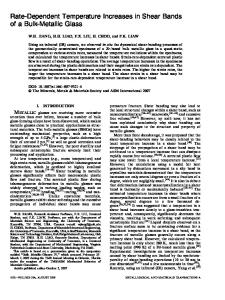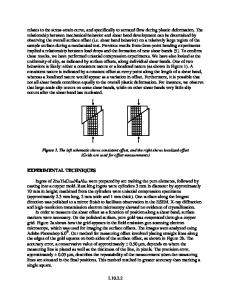Rate dependence of shear banding and serrated flows in a bulk metallic glass
- PDF / 152,388 Bytes
- 4 Pages / 585 x 783 pts Page_size
- 77 Downloads / 360 Views
Rate dependence of shear banding and serrated flows in a bulk metallic glass W.H. Jiang,a) G.J. Fan, F.X. Liu, and G.Y. Wang Department of Materials Science and Engineering, The University of Tennessee, Knoxville, Tennessee 37996
H. Choo Department of Materials Science and Engineering, The University of Tennessee, Knoxville, Tennessee 37996; and Materials Science and Technology Division, Oak Ridge National Laboratory, Oak Ridge, Tennessee 37831
P.K. Liaw Department of Materials Science and Engineering, The University of Tennessee, Knoxville, Tennessee 37996 (Received 29 March 2006; accepted 3 May 2006)
Using an infrared camera, we observed in situ dynamic shear-banding operations during compression of a bulk metallic glass at various strain rates. We demonstrated that the shear-banding events are highly dependent on strain rates, either intermittent at the lower strain rate or successive at the higher strain rate. Serrated plastic-flow behaviors are a result of shear-banding operations. These observations provide a new insight into inhomogeneous deformation of metallic glasses.
The recent development of bulk metallic glasses makes the applications of metallic glasses as structural materials become a reality.1–4 However, the poor ductility and subsequent premature fracture, which are imputed to the highly localized inhomogeneous deformation, still limit their applications.5 In spite of over 20 years of the intensive studies on the inhomogeneous deformation of metallic glasses, there are still contradictory understandings.6–12 Using a state-of-the-art infrared camera, we observed in situ dynamic shear-banding operations during compression of a bulk metallic glass at various strain rates. It is demonstrated that the shear-banding events are highly dependent on the strain rates, either intermittent at the lower strain rate or successive at the higher strain rate, affecting plastic-flow behaviors. These results provide insights into the strain-rate dependent shear-banding behaviors and their relationship with the serrated plastic flow that is widely observed in various loading modes.6–11,13–23 Inhomogeneous deformation of metallic glasses is characterized by shear banding. Shear banding on a
a)
Address all correspondence to this author. e-mail: [email protected] DOI: 10.1557/JMR.2006.0266 2164 J. Mater. Res., Vol. 21, No. 9, Sep 2006 http://journals.cambridge.org Downloaded: 18 Jan 2015
nanometer scale significantly affects the macroscopic plastic-flow behavior of metallic glasses, serrated versus smooth, which is dependent on the strain rate.8,10–13,16,17,22,23 The instability of shear banding makes it difficult to investigate the effects of strain rates on the plastic flow and shear-banding behavior in uniaxial loading. Considering that the shear-banding operation in compression is along about 45° with respect to the loading axis,24 we prepare the specimens with the height (h) to width (w) ratio (h/w) of 0.5, so a platen can hinder the excessive propagation of a few shear bands, avoiding premature fracture and de
Data Loading...











